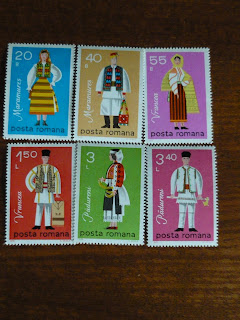



The following set as well as the Moldova's souvenir sheet depicts several Romanian winter traditions.
In Romania, the winter holiday season is truly in full-swing from December 24 to January 7. Highlights include: Christmas Day, New Year and Epiphany, with their respective eves. The most important feature of these celebrations is their unique variety of colorful Romanian customs, traditions, and believes, of artistic, literary, musical, and other folklore events, which make the winter holidays some of the most original and spectacular spiritual manifestations of the Romanian people.
The grown-ups caroling goes on Christmas evening and night. The waits -young and mature people - gather in groups and they choose a leader. When they are in the front yard of a house, they perform their repertory to the host. The songs are always accompanied by dance. When the performance is over, the host invites the carolers inside the house for food, drinks and presents.
Throughout the season, teenagers and young adults especially enjoy caroling with the “Goat”. The “Goat” is actually a usually boisterous young person dressed up in a goat costume. The whole group dances through the streets and from door to door, often with flute music. This tradition comes from the ancient Roman people and it reminds us of the celebration of the ancient Greek gods.
This custom is also called "brezaia" in Wallachia and Oltenia, because of the multicolored appearance of the goat mask. The goat jumps, jerks, turns round, and bends, clattering regularly the wooden jaws.
The small plough
Plugusorul is a small plough. In Romanian folklore is a traditional procession with a decorated plough, on New Years' Eve. This is a well wishing custom for the field fruitfulness into the new year. This custom arises from "Carmen arvale", a Roman wish for bountiful crops.
The ploughmen are teenagers and children carrying whips, bells and pipes in their hands.
"Sorcova" is a special bouquet used for New Year's wishes early New Year’s morning. Children wish people a “Happy New Year!” while touching them lightly with this bouquet. After they have wished a Happy New Year to the members of their family, the children go to the neighbors and relatives. Traditionally, the "Sorcova" bouquet was made up of one or several fruit - tree twigs (apple-tree, pear-tree, cherry-tree, plum-tree); all of them are put into water, in warm place, on November 30th (St. Andrew’s Day), in order to bud and to blossom on New Year's Eve.

And because any text must be followed by examples I will offer you two Romanian carolls sung by one of my favourite Romanian singers: Paula Seling



No comments:
Post a Comment